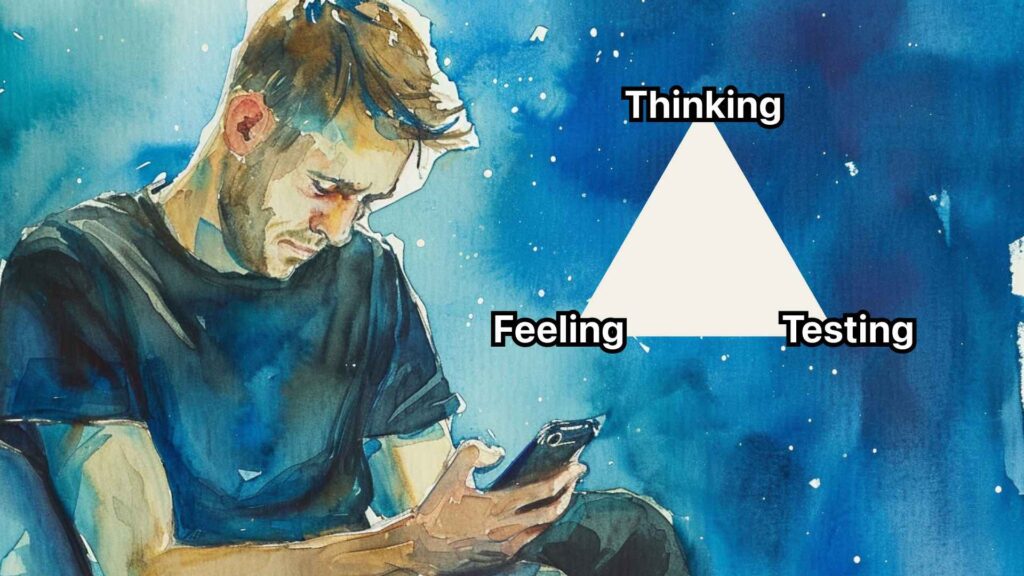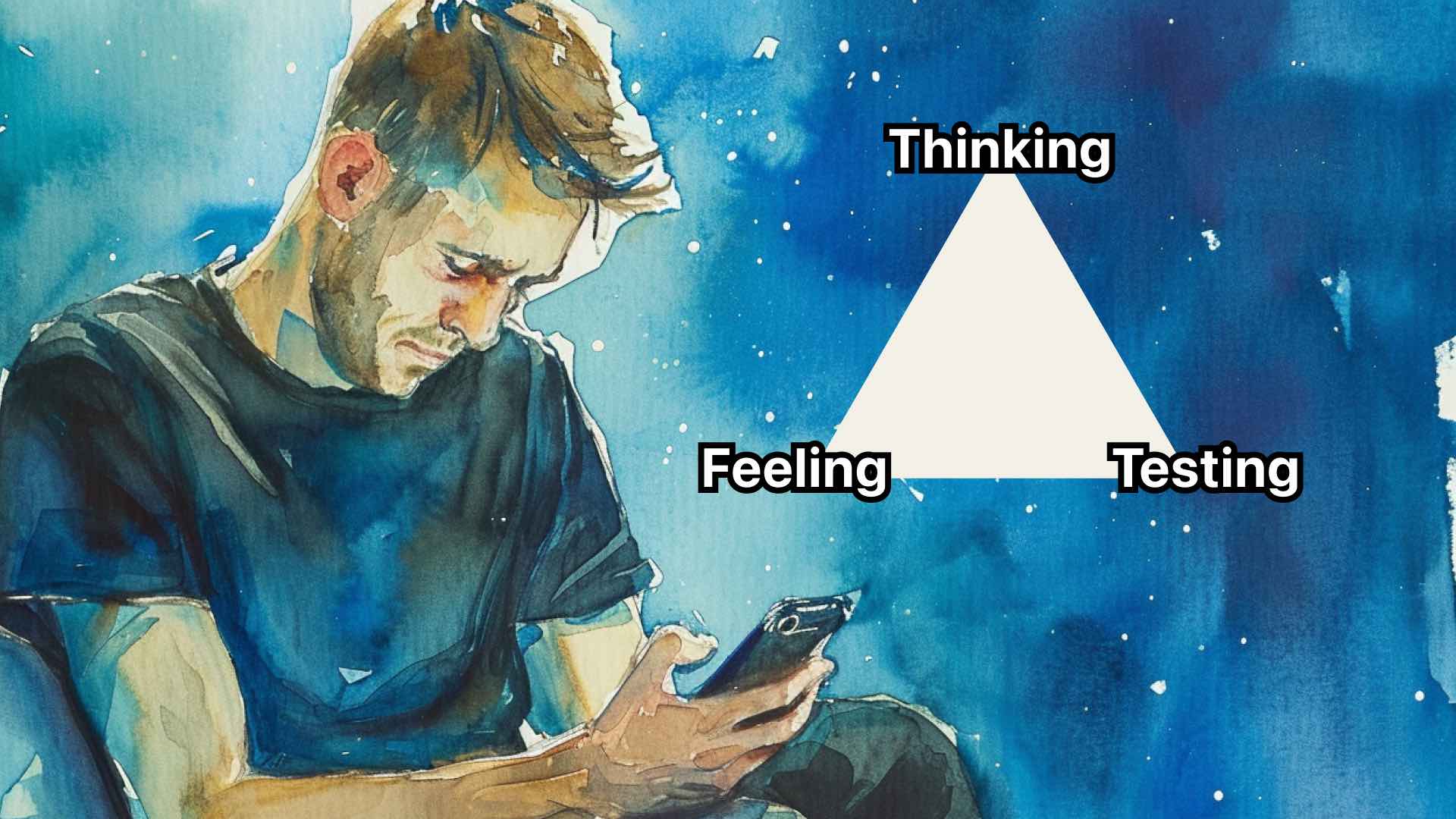Introduction: Navigating the Maze of OCD Thoughts
For many grappling with Obsessive-Compulsive Disorder (OCD), the journey isn’t just about managing visible behaviors; it’s also an internal battle with relentless thoughts and doubts. If you’re reading this, you might be all too familiar with the constant cycle of intrusive thoughts, the urge to perform rituals to quell these thoughts, and the fleeting relief that follows — only for the cycle to start again. This isn’t just about habits or quirks; it’s a cognitive loop that can feel like a maze with no exit.
But what if you could understand this maze? What if you could find a map that helps you navigate the complex pathways of your thoughts? This article aims to be that guide, focusing on the cognitive aspects of OCD — the “thinking – testing – feeling” triangle that forms the core of your experiences. Here, we’ll delve into how your thoughts, behaviors, and emotions interact and sustain the cycle of OCD. More importantly, we’ll explore how to manage and alter these thought patterns to break the cycle.
OCD is as much about what you think as it is about what you do. By recognizing and understanding the cognitive distortions at the heart of OCD — like the overwhelming need for certainty or the fear of the worst-case scenarios — you can start to regain control. It’s not just about suppressing thoughts or compulsions; it’s about fundamentally changing your relationship with your thoughts.
As you read on, remember that this journey is about progress, not perfection. Understanding and managing OCD is a process, and every step forward is a victory. So, let’s take that first step together and begin to understand the cognitive maze of OCD, finding strategies and hope within its complexities.

Section 1: Understanding OCD’s Cognitive Cycle
At the heart of Obsessive-Compulsive Disorder (OCD) lies a relentless cycle that goes beyond mere habits or rituals; it’s a complex interplay between thoughts, behaviors, and emotions — often referred to as the “thinking – testing – feeling” triangle. This cycle is not just a sequence but a trap that continually reinforces itself, making OCD a persistent and distressing condition. To manage OCD effectively, understanding each corner of this triangle is crucial.
The Thinking: Intrusive Thoughts and Cognitive Distortions
The cycle often begins in the realm of thoughts. These aren’t just any thoughts; they are intrusive and unwanted, popping into your mind without invitation. They might be fears of contamination, worries about harm, or distressing doubts. These thoughts are incredibly vivid and can feel intolerably real. However, the issue isn’t just the presence of these thoughts — everyone has unwanted thoughts at times — but how you interpret and respond to them.
Cognitive distortions are skewed ways of thinking common in OCD. They include:
- Catastrophizing: Imagining the worst possible outcome in every scenario.
- Overestimation of Threat: Believing that the perceived danger is far greater than it actually is.
- Black-and-White Thinking: Seeing things in extremes, with no middle ground.
- Need for Certainty: Striving for absolute assurance and zero doubt, which is an impossible standard.
The Testing: Compulsions and Avoidance
In response to these distressing thoughts, you might feel compelled to perform certain behaviors or rituals — these are the compulsions. The logic is understandable: if you’re plagued by the thought of contamination, cleaning obsessively seems like a reasonable way to alleviate that fear. However, these compulsions are not solutions; they are temporary fixes that reinforce the cycle.
Avoidance is another form of ‘testing’ or response. You might avoid certain places, people, or activities that trigger your intrusive thoughts. While avoidance might provide temporary relief, it also reinforces the fear and the belief that the only way to cope is by escaping.
The Feeling: Anxiety and Temporary Relief
The third corner of the triangle is the emotional response — primarily anxiety. Intrusive thoughts provoke intense anxiety, and compulsions are an attempt to relieve that distress. In the short term, you might feel a sense of relief after performing a compulsion or avoiding a trigger. However, this relief is fleeting. The underlying anxiety remains and often grows, as the belief that you must perform rituals to avoid disaster gets stronger with each cycle.
Breaking the Cycle
Understanding the “thinking – testing – feeling” triangle is the first step in breaking the OCD cycle. It’s about recognizing that the compulsion or avoidance, which seems like the solution, is actually part of the problem. Each component of the triangle feeds into the next, creating a self-sustaining loop of distress. The goal is not to just suppress the thoughts or compulsions but to change how you respond to them.
As you continue reading, remember that breaking this cycle is a gradual process. It involves learning new ways to respond to your thoughts, reducing the reliance on compulsions, and managing the anxiety that comes with change. With the right strategies and support, it’s possible to interrupt this cycle and regain control over your thoughts and life.

Section 2: Cognitive Patterns and Their Impact on OCD
In the quest to understand and manage Obsessive-Compulsive Disorder, many turn to an “OCD test” or “OCD diagnosis test” as a first step. These tests, often found online, can provide insight into the nature of your thoughts and behaviors, suggesting whether they align with typical OCD patterns. However, while these tools can be a useful starting point, they are just the beginning of understanding the complex cognitive patterns that underpin OCD.
The Search for Answers: OCD Tests
When you type “OCD test” into a search engine, you’re met with a variety of questionnaires and checklists designed to gauge your symptoms against the standard criteria for OCD. These tests typically ask about the frequency and intensity of your intrusive thoughts, as well as the compulsions you might use to alleviate the distress they cause. People are drawn to these tests out of a desire for clarity and certainty about their experiences. However, it’s important to remember that while these tests can be indicative, they are not definitive. A true diagnosis can only be made by a qualified mental health professional.
Understanding Cognitive Patterns in OCD
Beyond identifying whether your experiences align with OCD, it’s crucial to understand the specific cognitive patterns that fuel your symptoms. These patterns include:
- Comparing: Constantly comparing your behaviors or thoughts with others or what is perceived as ‘normal,’ which can exacerbate feelings of being flawed or abnormal.
- Fear of Uncertainty: A core feature of OCD where the inability to tolerate uncertainty leads to an endless quest for answers or reassurance.
- Coping with Doubt: The struggle to accept any level of doubt can lead to an over-reliance on compulsions as a way to achieve certainty.
Each of these patterns is a piece of the puzzle in understanding your OCD. They are the mental habits that keep you trapped in the cycle of intrusive thoughts and compulsive behaviors.
The Impact of Cognitive Patterns
These cognitive patterns don’t just exist in a vacuum; they have a real and profound impact on your life. They can dictate your actions, restrict your activities, and consume your mental energy. For instance:
- Comparing might lead you to constantly seek validation or proof that you’re not ‘bad’ or ‘crazy.’
- Fear of Uncertainty might make it difficult to make decisions or leave you stuck in a loop of ‘what if’ scenarios.
- Coping with Doubt can make you feel as if you’re one misstep away from disaster, leading to an over-reliance on compulsive behaviors to prevent perceived catastrophes.
Beyond the OCD Test
While an “OCD test” can be a helpful tool in your journey, understanding and managing these cognitive patterns require more than just a questionnaire. It involves a deep dive into your thought processes and learning strategies to manage and alter these patterns. Therapy, particularly Cognitive Behavioral Therapy (CBT), is often the most effective approach in changing these deeply ingrained cognitive habits.
Embracing the Complexity
As you move forward, remember that OCD is not a one-size-fits-all disorder. Your experience is unique, and so too will be your path to managing it. While “OCD tests” and diagnoses are a starting point, truly understanding and managing your OCD means looking beyond these tests and into the cognitive patterns that shape your world. It’s a journey that requires patience, understanding, and most importantly, a compassionate approach to changing how you think and respond to your thoughts.

Section 3: Tools and Strategies for Cognitive Management
Understanding and managing the cognitive patterns of OCD is a vital step towards recovery. This journey often involves various tools and strategies designed to challenge and change the maladaptive beliefs that fuel the disorder. Among these tools is the innovative OCD.app, a resource that provides cognitive exercises specifically tailored to address and alter the thought patterns associated with OCD.
Introducing OCD.app: A Cognitive Tool
OCD.app is more than just an application; it’s a guided pathway to better understanding and managing your OCD. It’s grounded in evidence-based practices and offers a range of cognitive exercises aimed at targeting the very beliefs that keep you trapped in the cycle of OCD. The app doesn’t just offer a temporary fix; it aims to bring about a lasting change in your thought processes.
- Personalized Exercises: The app provides exercises tailored to your specific patterns of thinking, ensuring a more personalized and effective approach to management.
- Progress Tracking: It allows you to track your progress over time, giving you a clear picture of how your thoughts and behaviors are changing.
How Cognitive Exercises Help
The cognitive exercises provided by OCD.app are designed to directly target and modify the maladaptive beliefs that underpin OCD. Here’s how they can help:
- Challenging Beliefs: Exercises encourage you to question and challenge the catastrophic predictions and rigid beliefs that fuel your OCD, helping you develop a more flexible and realistic way of thinking.
- Reducing the Need to Test and Compare: By addressing the beliefs that lead you to constantly check and seek reassurance, the app’s exercises reduce the perceived need for these behaviors. Over time, this can lead to a significant decrease in compulsive testing and comparing.
- Building Tolerance to Uncertainty: Many exercises focus on increasing your tolerance to uncertainty, a crucial aspect of reducing OCD symptoms. They help you gradually become more comfortable with doubt and the unknown, lessening the need for compulsions.
The Role of OCD.app in the Treatment Plan
While OCD.app is a powerful tool, it’s most effective when used as part of a broader treatment plan. It’s not a substitute for professional therapy but rather a complement to it. Here’s how it fits into the larger picture:
- Between Sessions: It can provide continuous support and practice in managing your thoughts between therapy sessions.
- Enhancing Therapy: The insights and progress you gain from the app can be brought into therapy sessions, helping to inform and enhance your treatment.
Moving Forward with Tools and Strategies
As you incorporate tools like OCD.app into your life, remember that managing OCD is a gradual process. It involves learning, unlearning, and relearning how to think and respond to your thoughts. Tools and strategies are your allies in this journey, providing the support and guidance needed to make lasting changes.
In the next section, we’ll explore how to break the cycle of OCD by identifying triggers, practicing response prevention, and embracing new ways of coping with anxiety and uncertainty. By combining understanding, tools, and strategies, you can take control of your OCD and move towards a life defined not by compulsions and fear but by resilience and hope.

Section 4: Breaking the Cycle of OCD
Breaking the cycle of OCD is about understanding and intervening in the “thinking – testing – feeling” triangle. It requires a multi-faceted approach that includes identifying triggers, practicing response prevention, and adopting new coping strategies. This section will guide you through these steps, helping you to disrupt the cycle and regain control over your thoughts and behaviors.
Identifying Triggers
The first step in breaking the cycle is to become aware of what triggers your intrusive thoughts and compulsive behaviors. Triggers can be external, like specific places or objects, or internal, such as certain thoughts or emotional states. Here’s how to start identifying your triggers:
- Keep a Journal: Note when your OCD symptoms arise and what’s happening at the time. Look for patterns over days or weeks.
- Mindfulness Practices: Engage in mindfulness to become more aware of your moment-to-moment experiences, helping you to identify triggers as they occur.
Practicing Response Prevention
Once you know your triggers, you can start practicing response prevention. This involves deliberately exposing yourself to a trigger and choosing not to engage in the compulsive behavior that typically follows. Here’s what you need to know:
- Gradual Exposure: Start with less challenging triggers and gradually work your way up to more difficult ones.
- Support: It’s often beneficial to undertake response prevention with the guidance of a therapist, especially when dealing with more challenging triggers.
Adopting New Coping Strategies
Breaking the cycle also means learning new, healthier ways to cope with the anxiety and uncertainty that come with OCD. Here are some strategies:
- Cognitive Restructuring: Learn to identify and challenge the irrational beliefs that underlie your OCD symptoms. Replace them with more balanced and realistic thoughts.
- Relaxation Techniques: Techniques such as deep breathing, progressive muscle relaxation, or meditation can help reduce the overall level of anxiety and stress.
- Building Tolerance to Uncertainty: Gradually expose yourself to small amounts of uncertainty, building your tolerance over time. Learn to accept that some level of uncertainty is a part of life.
Combining Strategies for Effective Intervention
Effective intervention often involves combining these strategies:
- While identifying triggers, you might also be challenging the thoughts that arise from exposure to these triggers.
- When practicing response prevention, you’re likely also using new coping strategies to manage the anxiety that comes from not performing compulsions.
- As you adopt new coping strategies, you’re changing the way you respond to thoughts and feelings, which in turn makes response prevention easier.
The Journey Forward
Breaking the cycle of OCD isn’t about a single moment of change; it’s about a series of steps and strategies that you implement over time. It requires patience, persistence, and often the guidance of a professional. Remember, each step forward, no matter how small, is a move towards a life not dominated by OCD. In the next section, we’ll discuss the importance of embracing uncertainty and doubt as a part of this journey, and how doing so can lead to lasting change.

Section 5: Embracing Uncertainty and Moving Forward
As we’ve explored the “thinking – testing – feeling” cycle of OCD, it’s clear that breaking this cycle is key to managing the disorder. However, a significant part of this journey involves embracing uncertainty and doubt, challenging tasks for anyone with OCD. This final section will discuss the importance of accepting uncertainty and provide strategies for doing so, concluding with some parting thoughts on your path forward.
The Importance of Embracing Uncertainty
OCD thrives on the need for certainty and the fear of the unknown. The compulsions and avoidance behaviors are attempts to create a sense of security and predictability. However, life is inherently uncertain, and learning to live with this uncertainty is a crucial step in overcoming OCD. Embracing uncertainty doesn’t mean you like or want it; it means you’re willing to accept it as a part of life.
Strategies for Building Tolerance to Uncertainty
- Gradual Exposure: Start by exposing yourself to small uncertainties. As you become more comfortable, gradually increase the level and complexity of the uncertainty you can tolerate.
- Mindfulness and Acceptance: Practice mindfulness to stay present and accept thoughts and feelings without judgment. Mindfulness helps you observe your need for certainty without acting on it.
- Cognitive Restructuring: Challenge the beliefs that fuel your fear of uncertainty. Replace thoughts like “I must know for sure” with “I can handle not knowing.”
Integrating Strategies into Daily Life
Integrating these strategies into your daily life isn’t a quick fix but a gradual process of change. It involves consistent practice and a commitment to confronting the discomfort of uncertainty. Over time, these strategies can help reduce the intensity and frequency of OCD symptoms.
The Journey Ahead
Managing OCD is a journey that requires patience, courage, and persistence. It’s a path filled with challenges and setbacks, but also growth and discovery. As you move forward, remember:
- You Are Not Alone: Millions of people understand what you’re going through. Seek support from therapists, support groups, or online communities.
- Celebrate Progress: Every step, no matter how small, is progress. Celebrate your victories and learn from your setbacks.
- Stay Committed: Keep practicing the strategies you’ve learned. Change takes time, and your efforts will pay off.
Conclusion
Understanding and managing OCD is a profound journey of self-discovery and resilience. Throughout this article, we’ve explored the “thinking – testing – feeling” triangle, recognized the patterns that sustain it, and discussed strategies to break the cycle. Embracing uncertainty is not just a step in managing OCD; it’s a step towards a more flexible, fulfilling life.
As you continue your journey, remember that change is possible. With each day and every challenge, you’re building a stronger, more adaptive way of living. OCD doesn’t define you; it’s just one part of your story. And as you turn each page, you’ll find yourself not just surviving but thriving.
